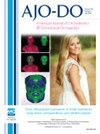Evaluation of trueness and precision of 3 face-scanning devices
IF 3
2区 医学
Q1 DENTISTRY, ORAL SURGERY & MEDICINE
American Journal of Orthodontics and Dentofacial Orthopedics
Pub Date : 2025-05-05
DOI:10.1016/j.ajodo.2025.04.009
引用次数: 0
Abstract
Introduction
This study evaluated the trueness and precision of three 3-dimensional facial scanning devices—MetiSmile (MS), Revopoint Miraco Plus (RMP), and Qlone Dental application (QA) using an iPhone 15 Pro.
Methods
Forty-seven participants were scanned using MS, RMP, and QA under standardized conditions. Comprehensive accuracy evaluations (trueness and precision) were conducted. Deviations were assessed through superimposition, and the root mean square (RMS) was used to quantify these deviations. The deviation analysis was performed using CloudCompare software (v2.13.2, www.cloudcompare.org).
Results
Trueness analysis showed that MS and RMP produced comparable results with deviations below 0.5 mm, whereas QA exhibited significantly higher deviations (P = 0.003; mean RMS = 0.938 mm for full-head scans). Precision analysis revealed MS had the lowest mean RMS deviation (0.309 mm), indicating the highest consistency, followed by RMP (0.362 mm). QA demonstrated the least precision (mean RMS = 0.657 mm). Comparative analysis indicated MS and RMP scans were similar, whereas QA showed greater deviations.
Conclusions
The MS and RMP devices exhibit high accuracy, making them suitable for orthodontic diagnostics and treatment planning. Although less accurate, the QA is also applicable for these purposes.
3种人脸扫描设备的真实感和精度评价。
本研究利用iPhone 15 Pro对metismile (MS)、revpoint Miraco Plus (RMP)和Qlone Dental application (QA)三种三维面部扫描设备的准确性和准确性进行了评估。方法:在标准条件下,采用质谱、RMP和QA对47名受试者进行扫描。进行了综合准确度评价(正确率和精密度)。通过叠加来评估偏差,并使用均方根(RMS)来量化这些偏差。使用CloudCompare软件(v2.13.2, www.cloudcompare.org)进行偏差分析。结果:准确度分析显示,MS和RMP产生的结果具有可比性,偏差小于0.5 mm,而QA的偏差明显更高(P = 0.003;全头部扫描平均RMS = 0.938 mm)。精密度分析显示,MS的均方根偏差最小(0.309 mm),一致性最高,RMP次之(0.362 mm)。QA的精密度最低(平均RMS = 0.657 mm)。对比分析表明MS和RMP扫描结果相似,而QA显示出更大的偏差。结论:MS和RMP器械具有较高的准确性,适用于正畸诊断和治疗计划。虽然不太准确,但QA也适用于这些目的。
本文章由计算机程序翻译,如有差异,请以英文原文为准。
求助全文
约1分钟内获得全文
求助全文
来源期刊
CiteScore
4.80
自引率
13.30%
发文量
432
审稿时长
66 days
期刊介绍:
Published for more than 100 years, the American Journal of Orthodontics and Dentofacial Orthopedics remains the leading orthodontic resource. It is the official publication of the American Association of Orthodontists, its constituent societies, the American Board of Orthodontics, and the College of Diplomates of the American Board of Orthodontics. Each month its readers have access to original peer-reviewed articles that examine all phases of orthodontic treatment. Illustrated throughout, the publication includes tables, color photographs, and statistical data. Coverage includes successful diagnostic procedures, imaging techniques, bracket and archwire materials, extraction and impaction concerns, orthognathic surgery, TMJ disorders, removable appliances, and adult therapy.

 求助内容:
求助内容: 应助结果提醒方式:
应助结果提醒方式:


